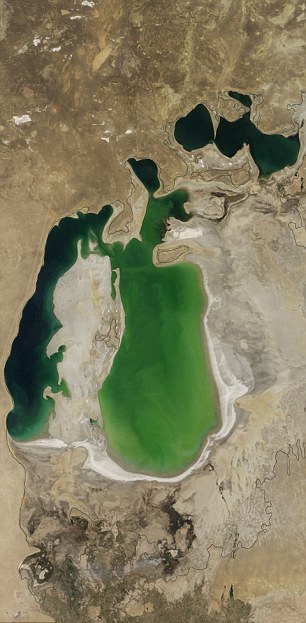American space agency NASA has published a satellite imagine of the Aral Sea made on 19 August 2014. The photo shows that the worst has happened: the eastern basin of the Southern Sea has completely turned into a desert.
.jpeg)
"This is the first time the eastern basin has completely dried in modern times," said Philip Micklin, a geographer emeritus from Western Michigan University and an Aral Sea expert, according to NASA.
"And it is likely the first time it has completely dried in 600 years, since Medieval desiccation associated with diversion of Amu Darya to the Caspian Sea," he added.
The agency's report shows a photograph taken in August 25, 2000, where the eastern part of the sea is still relatively abounding. In black is outlined the level of the sea back in the 1960s, prior to when the waters of the Amu Darya and Syr Darya rivers started to be intensively used for irrigation.

The difference across the years is staggering.
Below is a comparison of space images made by NASA in the period between 2000 and 2014:
.gif)
The Aral Sea was once the fourth largest lake in the world. Its drying out began in the 1960s, after the Soviet Union decided to divert water from the Amu Darya and Syr Darya rivers to irrigate fields in Kazakhstan, Uzbekistan and Turkmenistan.
This proved to be successful in the fields - the desert started blooming - but the damage to the lake was irreparable.
The water level declined and Northern (Small) Aral Sea became separated from the Southern (Large) Aral Sea. Over time, the Southern Sea became divided into eastern and western parts. In 2005, a dam was built to separate the northern and southern parts, so as to preserve at least the smaller northern part. The southern part was judged to be beyond rescue.
Desertification of the once flourishing area resulted in the weather becoming harsher: winters become colder, summers became hotter and dryer.
The bottom of the sea now exposed is not only salty but also contaminated with agricultural chemicals that pose a threat to the health of the locals.
Here is a video provided by EarthOutreach that describes the case of the Aral Sea.
According to Uzbek scientist Zenovyi Novitsky, saving the Aral Sea territory from desertification is possible by planting trees on the dried bottom. His calculations show that desiccation of the Aral Sea has already created more than 4.7 million hectares of salty land.
Novitsky said that afforesting the dried up bottom of the Aral Sea is the task of two countries – Kazakhstan and Uzbekistan. He added that the scientists from two countries had to work together.
"A huge forest will solve the problem of the dry seabed in ten years. Then the local community can also engage in animal husbandry," Novitsky said in an interview to Uznews.net.
"This area should be called "Aralkum" [“kum” stands for “sand”], the fastest-growing desert in the world. And it is the most important factor in the ecological destabilization of the region," the scientist stressed.
By Dinara Urazova


